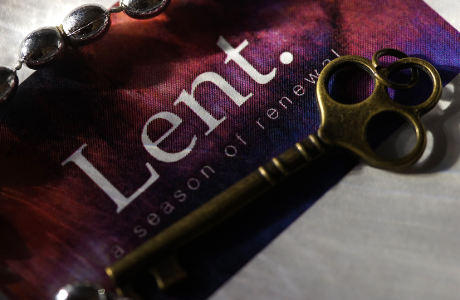Ash Wednesday, originally called dies cinerum (day of ashes) is mentioned in the earliest copies of the Gregorian Sacramentary, and probably dates from at least the 8th Century. One of the earliest descriptions of Ash Wednesday is found in the writings of the Anglo-Saxon abbot Aelfric (955-1020). In his Lives of the Saints, he writes, “We read in the books both in the Old Law and in the New that the men who repented of their sins bestrewed themselves with ashes and clothed their bodies with sackcloth. Now let us do this little at the beginning of our Lent that we strew ashes upon our heads to signify that we ought to repent of our sins during the Lenten fast.” This quotation confirms what we know from other sources, that throughout the Middle Ages ashes were sprinkled on the head, rather than anointed on the forehead as in our day.
As Aelfric suggests, the pouring of ashes on one’s body (and dressing in sackcloth, a very rough material) as an outer manifestation of inner repentance or mourning is an ancient practice. It is mentioned several times in the Old Testament. What is probably the earliest occurrence is found at the very end of the book of Job. Job, having been rebuked by God, confesses, “Therefore I despise myself and repent in dust and ashes” (Job 42:6). Other examples are found in 2 Samuel 13:19, Esther 4:1,3, Isaiah 61:3, Jeremiah 6:26, Ezekiel 27:30, and Daniel 9:3. In the New Testament, Jesus alludes to the practice in Matthew 11:21: “Woe to you, Korazin! Woe to you, Bethsaida! If the miracles that were performed in you had been performed in Tyre and Sidon, they would have repented long ago in sackcloth and ashes.”
In the typical Ash Wednesday observance, Christians are invited to the altar to receive the imposition of ashes, prior to receiving the holy Supper. The Pastor applies ashes in the shape of the cross on the forehead of each, while speaking the words, “For dust you are and to dust you shall return” (Genesis 3:19). This is of course what God spoke to Adam and Eve after they eaten of the forbidden fruit and fallen into sin. These words indicated to our first parents the bitterest fruit of their sin, namely death. In the context of the Ash Wednesday imposition of ashes, they remind each penitent of their sinfulness and mortality, and, thus, their need to repent and get right with God before it is too late. The cross reminds each penitent of the good news that through Jesus Christ crucified there is forgiveness for all sins, all guilt, and all punishment.
Ash Wednesday, like the season of Lent, is never mentioned in Scripture and is not commanded by God. Christians are free to either observe or not observe it. It also should be obvious that the imposition of ashes, like similar external practices, is meaningless, even hypocritical, unless there is a corresponding inner repentance and change of behaviour. This is made clear in Isaiah 58:5-7 when God says,
Is this the kind of fast I have chosen, only a day for a man to humble himself? Is it only for bowing one’s head like a reed and for lying on sackcloth and ashes? Is that what you call a fast, a day acceptable to the LORD? “Is not this the kind of fasting I have chosen: to loose the chains of injustice and untie the cords of the yoke, to set the oppressed free and break every yoke? Is it not to share your food with the hungry and to provide the poor wanderer with shelter– when you see the naked, to clothe him, and not to turn away from your own flesh and blood?
Yesterday 36 people were killed and thousands were injured in North India as an estimated 100 million people seeked to wash their sins in the holy river before the sun and moon changed – they only have 12 days every 10 years to do this. It is expected that thousands will die as people fight to get a place – they are so desperate. With this in mind, let the 40-Days of Prayer & Fasting be a wonderful time for repentance and spiritual renewal by reminding ourselves of what has been achieved on our behalf by Jesus’ sacrifice. It is only by Jesus’ death and resurrection that we are cleansed from sin, guilt and shame, and have the confidence of being right with God. Let this time be a time of great rejoicing in that truth ~ and a time of prayer for others, like those in India, who need to know Jesus’ love and grace.




